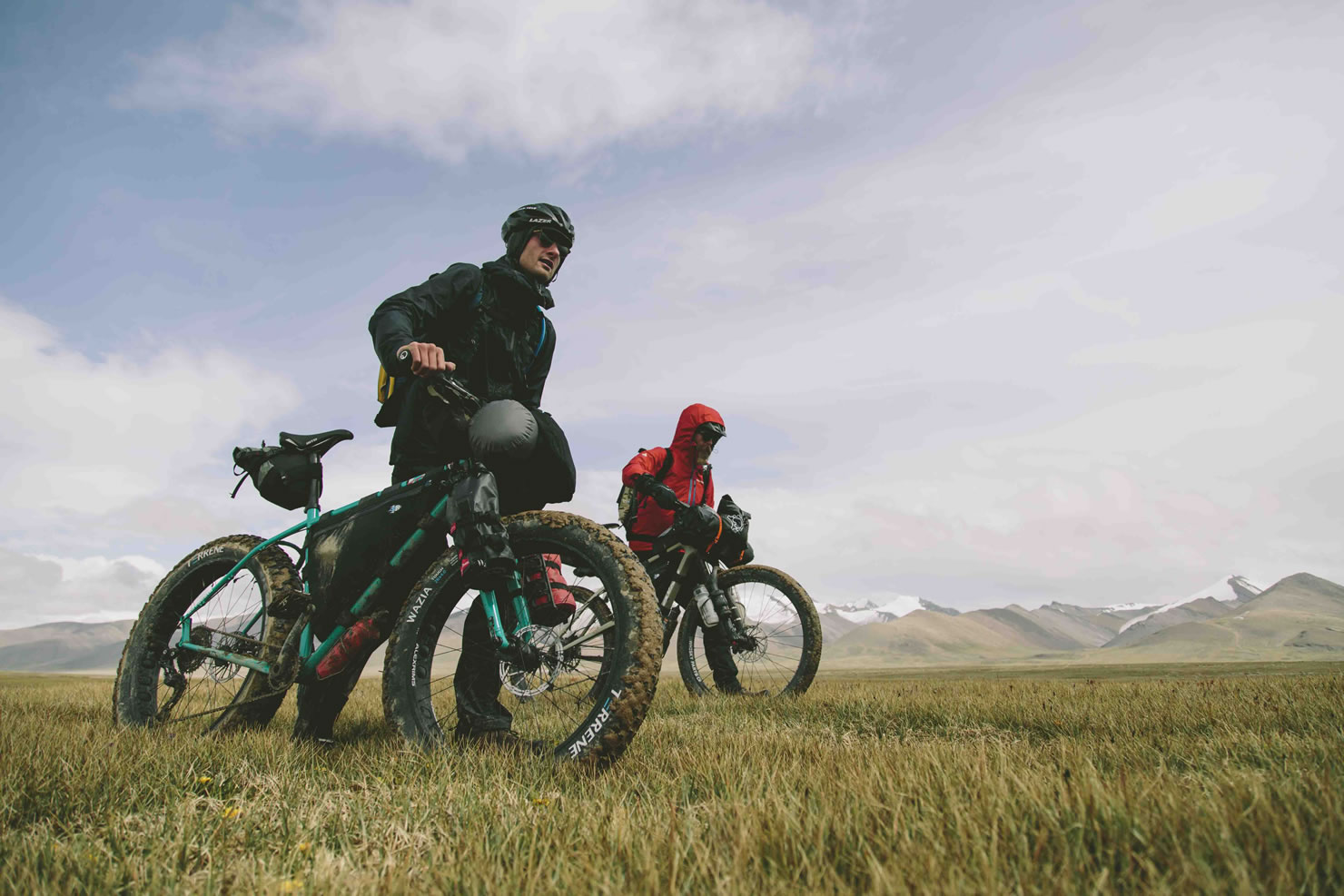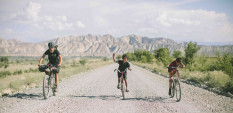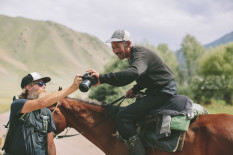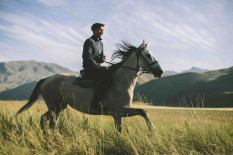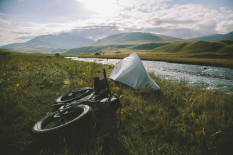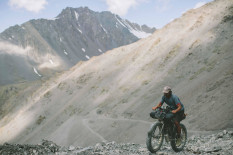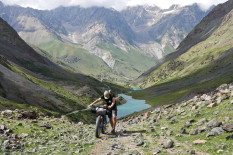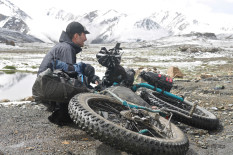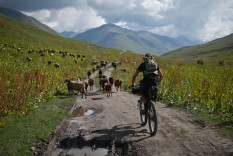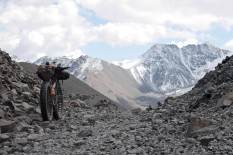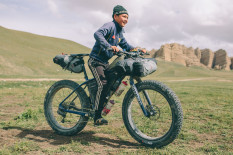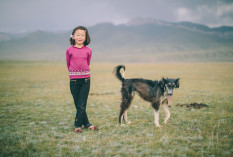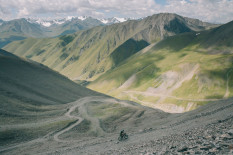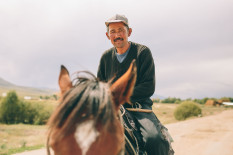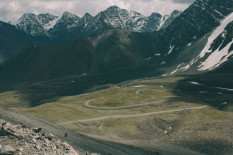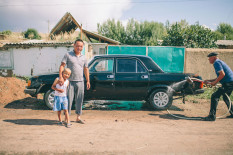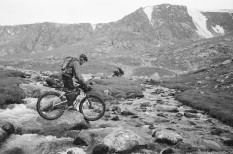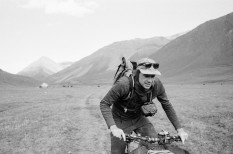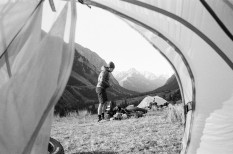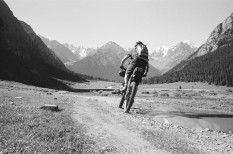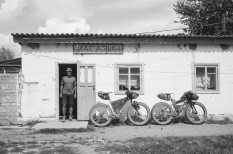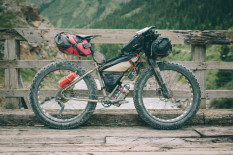Tian Shan Traverse, Kyrgyzstan
Distance
613 Mi.
(987 KM)Days
20
% Unpaved
95%
% Singletrack
5%
% Rideable (time)
98%
Total Ascent
49,000'
(14,935 M)High Point
12,600'
(3,840 M)Difficulty (1-10)
7.5?
- 5Climbing Scale Moderate80 FT/MI (15 M/KM)
- -Technical Difficulty
- -Physical Demand
- -Resupply & Logistics

Contributed By
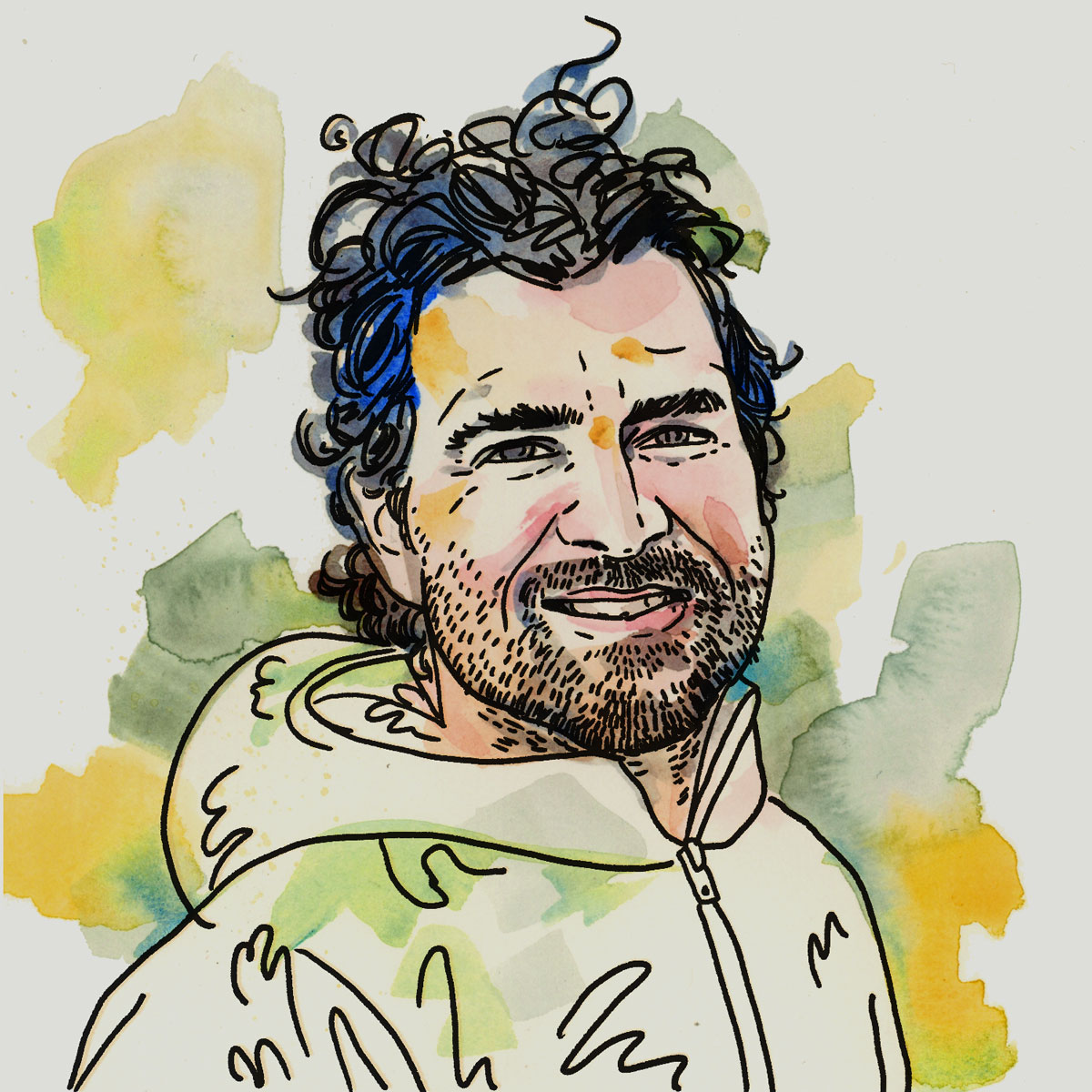
Joe Cruz
Contributing Editor
We’ve camped at the edge of a small village and a young sheep herder has come out to greet us. With us lacking Kyrgyz or Russian we communicate through pantomime. He has an idea. His cousin lives in the USA, so he calls her on his mobile so that she can translate. Nuri is stunned that we’re in her mother’s childhood hamlet and talking to Tamerlan. The cousins want to know why we chose Kyrgyzstan for cycle touring. For us, the question hardly makes sense anymore. We’ve been here for two and half weeks and the rumors of Kyrgyzstan’s sublime beauty and of the outgoing friendliness of the people have been confirmed tenfold.
Photos by Joel Caldwell, Joe Cruz, Logan Watts, and Lucas Winzenburg
Kyrgyzstan is in the cloud scraping peaks of the Tian Shan—in Chinese it’s the range of the ”heavenly mountain” that meets up with the Pamirs and Altai. The country is glaciers and crystal blue sunshine and mirror lakes, long lonely valleys with low grass like a golf fairway. It’s nomads who have moved their herds to high pasture in summer, living with their families in yurts. It’s breathless four thousand meter passes, scree slopes and lumpy marshland plateaus requiring river crossings. It’s roaming curious horses and the smell of sage at every star domed wild campsite. And it’s blocky central asian urban areas with Soviet era monuments and facades.
This nearly one thousand kilometer route follows a curve from the far east of the country back to Bishkek, the modest capital. It’s different from more familiar Silk Road tours that take in Osh and the Pamir Highway in the southwest, as it’s oriented toward a wilderness experience. On the other hand, this trip is well within reach for an intrepid rider looking to try out a more remote bikepacking tour than usual. Though the terrain can be rough, the cultural and logistical dimensions of travel in Kyrgyzstan are not difficult. To us, the ‘Stans first and most mean hospitality, history, and amazing landscapes. Certainly don’t let the news make you think otherwise.
A substantial mix of riding textures awaits. There are day long climbs up through trees and then above treeline on dirt tracks that get narrower as they get higher. There’s cumulatively a few hours of hike-a-bike. There are dusty wide dirt roads where you’ll pull up your buff to cover your nose and mouth when trucks come by. Much of this trip is doubletrack through grass where a couple of times a day a beat up Russian Lada will come chugging through or a livestock truck struggles along. Sometimes we couldn’t quite find the track, but that was fine: we pedaled over the steppe in the direction that we were seeking. We had three to six day spans between towns, so there was a sense of remoteness but not a complete lack of infrastructure. Almost every day we encountered Kyrgyz on horseback eager to come over and shake hands and acknowledge our visit, even if we could rarely communicate anything more ambitious than our joy and appreciation.
Between us we’ve been to many corners of the globe, but by early on in our trip to Kyrgyzstan, we were ready to declare its landscapes as transcendent as any we’ve seen.
Submit Route Alert
As the leading creator and publisher of bikepacking routes, BIKEPACKING.com endeavors to maintain, improve, and advocate for our growing network of bikepacking routes all over the world. As such, our editorial team, route creators, and Route Stewards serve as mediators for route improvements and opportunities for connectivity, conservation, and community growth around these routes. To facilitate these efforts, we rely on our Bikepacking Collective and the greater bikepacking community to call attention to critical issues and opportunities that are discovered while riding these routes. If you have a vital issue or opportunity regarding this route that pertains to one of the subjects below, please let us know:
Highlights
Must Know
Camping
Food/H2O
Resources
- Some of the most sublime landscapes we’ve ever ridden.
- Friendly, outgoing locals who may invite you into their yurts for chai, kumys (fermented mare’s milk), or vodka.
- Wild and remote steppes.
- Curious and confident herds of horses visiting camp.
- The descent toward Beatov—starting around mile 285/kilometer 459—affords views that somehow exceed the already stratospheric standard set by the rest of the country.
- Song-Köl Lake (well-loved by Kyrgyz tourists and therefore with no shortage of trash and signs of overuse, but still spectacular).
- Kok-Boru, games where horse riders compete to drag a goat carcass to the opposing team’s endzone.
- Fly in and out of the capital, Bishkek.
- When to go: Due to a lot of snowfall at higher elevations, July to September is the best time to ride this route.
- Changing money is easy at the numerous small money changing storefronts in Bishkek. Rates are published on the outside and are fair. You get a slightly better exchange rate with big bills—US$50’s and US$100’s. Money can also be changed in Naryn and Baetov. Don’t expect to anywhere else on this route, however.
- In Bishkek, Naryn, and Baetov we had no trouble finding English speakers. English was very rare elsewhere.
- We hired a sprinter van and driver to take us to the start of the route in Kyzyl-Suu. Making this arrangement wasn’t complicated: we went to the main bus/taxi stand in Bishkek, found an english speaking driver, and relied on his help in asking around until we found transportation. It cost approximately US$150 total for the four of us with our bicycles and gear. Obviously, one could ride from Bishkek to Kyzyl-Suu, and there is likely to be an interesting route north of enormous Lake Issyk-Kul. This would add 3-5 days to the trip.
- Kyrgyzstan is mountain country (think Colorado or Switzerland). Come prepared with appropriate clothing and kit. It can snow at elevation in midsummer while the valley bottoms will have you sweating in shorts and t-shirt.
- There will be river crossings, so have a plan. E.g., bring a pair of sandals to change into or a pair of gore-tex socks to wear.
- We did this trip on three fat and one plus bike. They were ideal for the diverse and sometimes broken demanding terrain we encountered. At least one day is through rolling marshland with no regular track. Experienced riders with a good attitude could do this route on standard 2.2 inch wide mountain bike tires, especially with front suspension. There are numerous sections, however, where a traditional touring pannier setup with 1.7 tires on a drop bar bike would likely be overwhelmed or at least not much fun.
- The route includes an out-and-back spur to Tash Rabat, a 15th century silk road caravanserai and a well known tourist destination. We found the ruins there underwhelming and can’t recommend it. Still, it is an historically important area and the restored structure does give a sense of a romantic past. There are a few tourist yurt camps on the Tash Rabat road where an excellent inexpensive meal can be purchased.
- With its wide open spaces and traditional nomadic culture, wild camping in Kyrgyzstan is not only a cinch, it would be madness to spend the night in any other way. Our biggest camping challenge was deciding between merely gorgeous versus unspeakably astonishing campsites.
- Naryn has reasonably budget friendly lodging options including homestays and hotels. Stop in at the tourist office straightaway to avoid riding around town to check vacancies.
- Bishkek has a wide range of lodging, from US$10/night hostels to expensive western chain luxury hotels.
- It is crucial to ride a setup that can carry at least five days of food, preferably extendable to six or seven. The first 170 miles has no resupply opportunities. Riding fast could cover this distance, of course, in fewer than the five and a half days it took us, but we think that would be missing the beauty of the place.
- Do initial shopping in Bishkek; Kyzyl-Suu has no grocery store to speak of.
- Naryn has large grocery stores and a lively outdoor market.
- After Naryn, resupply opportunities are more frequent but still sometimes several days apart. Reliable groceries and restaurants can be found in At-Bashy and Baetov. There is a small store in a tent on the south shore of Song-Köl, but it is seasonal and the stock is highly contingent on when the merchant last drove to the market. There are more permanent small stores at Kojomkul and Djong-Alysh (the route includes an out-and-back detour to the latter). Selection at the small stores is very limited and will require that you get creative with your meals. #ramencircus.
- Herdswomen will sell delicious loaves of bread that they’ve baked in their yurt, but some won’t be able to help seeing it as an opportunity for a ludicrous markup.
- Water is widely available in streams, rivers, and lakes, but should be purified. We each had a carry capacity of 3-5 liters and that was plenty sufficient for getting us between sources.
- At the end of your ride, be sure to visit Sierra Coffee in Bishkek. The great staff and friendly expat owner serve beer, real coffee, and excellent food.
Additional Resources
- Feature Story: Don’t Whistle Indoors
- Joe’s Blog entries from Kyrgyzstan
Terms of Use: As with each bikepacking route guide published on BIKEPACKING.com, should you choose to cycle this route, do so at your own risk. Prior to setting out check current local weather, conditions, and land/road closures. While riding, obey all public and private land use restrictions and rules, carry proper safety and navigational equipment, and of course, follow the #leavenotrace guidelines. The information found herein is simply a planning resource to be used as a point of inspiration in conjunction with your own due-diligence. In spite of the fact that this route, associated GPS track (GPX and maps), and all route guidelines were prepared under diligent research by the specified contributor and/or contributors, the accuracy of such and judgement of the author is not guaranteed. BIKEPACKING.com LLC, its partners, associates, and contributors are in no way liable for personal injury, damage to personal property, or any other such situation that might happen to individual riders cycling or following this route.
Please keep the conversation civil, constructive, and inclusive, or your comment will be removed.







